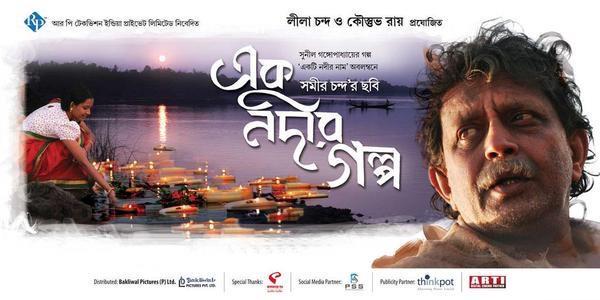Is strict fidelity to the original literary source possible? Or is it even necessary? Should we, as viewers, take fidelity as a methodological principle to be followed by the filmmaker who chooses to adapt a literary source to make his film? All these questions get raised as one watches production designer Samir Chanda’s entry into direction with Ek Nodir Galpo. Based on a story Ekti Nodir Naam, authored by the noted Sunil Gangopadhyay that haunted Chanda from the time he was in college, Ek Nodir Galpo moves beyond the limitations of the written word. It defines grief as an overwhelming emotion that can change the life of a man, less than ordinary, radically and irreversibly for an extraordinary and unique cause.
Ek Nodir Galpo is a poignant celluloid document that throws up an extraordinary perspective on the dedication of a human being towards a cause that may seem crazy to most. Through what may seem a simple story of love between a father and his motherless daughter, the film subtly but steadily covers other areas such as, our losing link with nature presented metaphorically through the river; the casual negligence of officialdom when the person approaching it is either thought to be nutty, or poor, or both; the value-centric integrity that still sustains among a few officers; the empathy that sometimes peeps out of the steel exterior of a strict DM; the river presented as a physical reality, as an integral part of the lives of those who live near it, the river as a metaphor for the anger presented through high tide, as a vehicle of death, as a soother of the mind, as a carrier of dead bodies, as an indirect upholder of the human spirit; and finally, the river as a symbol of Darakeshwar’s dead daughter if only through its imaginary new name, Anjana. The river is an omnipresence that carries ambivalent meanings throughout the film. True to its name, symbolically speaking, the film is more the story of a river than of a father and his daughter.
At the heart of the film, its life and soul is the superb performance of Mithun Chakraborty as Darakeshwar. As he struggles to get the river named after his daughter, he changes his looks, his body language and even his voice. He stops shaving or going for a haircut becoming oblivious to the tattering clothes on his body, or the strange stares of people as he stands up on a makeshift podium to make an impromptu speech asking the people to sign on his signature campaign, or, to the boys who pelt him with stones as he walks by. Contrast this to the scenes with him as the smiling father laughing away at his daughter’s pranks, or making plans for her future and you see one of the most memorable performances come alive on screen by any actor in any language in the history of Indian cinema. This is perhaps Mithun’s best performance ever, Mrigaya (1976) and Tahader Katha, notwithstanding. Shweta Prasad as the adolescent daughter, Anjana, is a natural performer who does not betray any awe about acting with one of the best actors Indian cinema has ever produced. Krishnakishore Mukherjee as the kindly but stern DM and Jisshu Sengupta as the conscience-ridden police officer are very good too as are Bulbul Choudhury as the concerned neighbour and Rahul Prasad as her grandson.
Nachiketa who has done the musical score for the film, revives an old folk number sung by young brides and marriageable girls. The song offers a point of relief in the tragic story of love on the one hand and the strength of the human spirit on the other. The music has a gentle flow to it, in harmony with the river flowing along. Rajen C Kothari’s cinematography is low-key and subtly captures the village ambience with its browns and ambers aesthetically. Shot almost entirely on location along the banks of the river Bhagirati, in a village called Naliapur in Burdwan district, the film is a rich visual experience. Anup Mukherjee’s sound design flows like the soft and soothing waves of the Keleghai river. Sanjib Kumar Datta’s editing does justice to the dramatic changes in the mood of the film from innocent joy, to a bonding between two individuals, through shock, grief, moving from the village to the neighbouring town into government offices to village market places and streets only to come back, like the proverbial bad coin, again and again, to the banks of the Keleghai river. Chanda’s dialogue retains the local inflections of the Bengali dialect spoken by the region the film portrays.
There are three National Award winners sharing the credits of the film. One is director Samir Chanda himself who, as production designer, has won several National Awards, Mithun Chakraborty is another National Award winner several times over and the third is Shweta Prasad, who won the National Award for the Best Child Artiste in 2003. But these hardly count in a film where the contribution of every single member of the team speaks for itself. One hopes Chanda sustains the spirit of excellence and dedication he reveals in his first film, much like his protagonist’s single-minded dedication to attain an incredible goal. In a film like this, you can cheerfully forget the story it has been adapted from. For Ek Nodir Galpo, the film is the story.
Bengali, Drama, Color
https://www.youtube.com/watch?v=0XV5JpMwhSE


